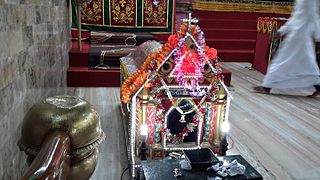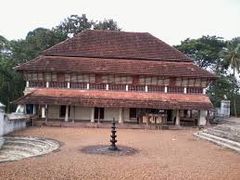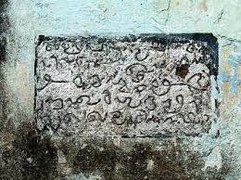Kadamattathu Kathanar

Kadamattathu Kathanar was a kathanar (priest) who, according to legends, possessed magical powers. He was an ordained deacon of Kadamattom Church in the 9th century, now affiliated to the Malankara Syriac Orthodox Church, Kadamattam near Muvattupuzha in Ernakulam district, Kerala. According to legends, his real name was Poulose and he was the disciple of bishop Mar Abo. The church's history is undocumented, surviving solely through local legends. The tales surrounding Kathanar encapsulate the experiences of the local populace, conveyed through elements of magic and sorcery. These tales portray him as a priest with supernatural powers, employed for the common good.[1]
Historicity
[edit]
In medieval legends, history and fables were combined inextricably.[2] The story of Kadamattathu Kathanar might be a mixture of history and fables. Currently there is no certain proof that he really existed, but the fact that a real priest lived in that area in the ninth century cannot be denied.[3] Tradition points out the existence of Christians in the area from 5th century of the Christian Era.[4]
Legends
[edit]This section needs additional citations for verification. (September 2023) |
Poulose, later known as Kathanar, was born to a poor family in Kadamattom, a small village in North Travancore (now part of Kerala). People fondly called him Kochu Poulose. He had no siblings and his parents died when he was a child. He was taken care of by his mother for a short period before her death, after which he came under the patronage of the Persian priest Mar Abo (also known as Mar Sabor).[5]
Poulose was given a good education under Abo. The priest taught him Syriac and Liturgy of the Mass. In due course he was ordained as a deacon and people began to call him deacon Poulose. The legend of Kadamattathu Kathanar goes that a priest entrusted a servant boy with his cattle. A tiger killed one, causing panic. The community searched, finding the cattle except one. But Poulose, who was in search of the cattle himself went missing. Fears arose that he, too, fell prey to the tiger. The priest remained hopeful despite evidence against the deacon. Poulose was indeed alive, having lived among a tribal community called the Mala Arayas. He learned mystical arts and secrets during his time there but eventually escaped, evading the tribe's attempts to recapture him, including a devilish storm aimed at the church where he sought refuge.[6]
Legend tells of Kathanar seeking refuge inside the church when the cannibalistic tribes summoned a storm to destroy it and capture him. They conjured iron hot chains and whipped at the church door in their pursuit. Kathanar prayed to Mother Mary for deliverance, and the church doors remained shut until the townspeople arrived, scaring the Arayas away. The scars on the church doors testify to the power of the Mala Arayas and Kathanar's miraculous escape.
Mar Sabor the bishop who ordained him as a priest left from Kadamattom after the arrival of Paulose. The Bishop built many churches.[7] Sabor settled at Thevalakkara.[8]
Some stories of Kathanar are presented in the collection of legends, Aithihyamala.[9][10]
Gallery
[edit]-
Famous Persian Cross- front view
-
Persian Cross-side view
-
Altar of the church
-
External view of the church
-
Tomb of Marthoma IX
-
Bishops rest room built in the late 1940s or earlier
-
Unknown inscription on the wall of the church
In popular culture
[edit]- In the 1966 film Kadamattathachan, Prem Nazir played the lead role.
- A TV series Kadamattathu Kathanar was telecast on Asianet in which Prakash Paul played Kathanar.[11][12]
- A TV series was produced by Jai Hind and Surya TV titled Kadamattathachan. Prakash Paul played the title role in both.[13][14]
- In the film Megasandesam, Napoleon plays the role of a descendant of Kadamattathu Kathanar.
- The 2024 film Kathanar - The Wild Sorcerer based on the character stars Jayasurya as Kathanar.
See also
[edit]References
[edit]- ^ "Kathanar's Kadamattam". The Hindu. 18 February 2005. Archived from the original on 6 April 2005. Retrieved 11 May 2011.
{{cite web}}: CS1 maint: unfit URL (link) - ^ "A symbol of amity". The Hindu. 1 August 2004. Archived from the original on 9 November 2012. Retrieved 17 May 2011.
- ^ "Chera times of the Kulasekharas". kerala.cc. Retrieved 17 May 2011.
- ^ Kottoor_kulangattil Family Magazine 2012 (Kottoor Church History)
- ^ "St. Mar Abo festival". The Hindu. 28 January 2011. Archived from the original on 9 November 2012. Retrieved 17 May 2011.
- ^ Morbid, Mr (6 May 2023). "Kadamattathu Kathanar, the True Story Behind the Sorcerer Priest of Kerala - Morbid Kuriosity". Retrieved 3 May 2024.
- ^ Joseph, Thomas. "Mor Sabor-Mor Aphroth, Akaparambu". sor.cua.edu.
- ^ "മര്ത്തമറിയം ഓര്ത്തോഡോക്സ് സിറിയന് ചര്ച്ച്, തേവലക്കര - Mar Abo". Archived from the original on 18 February 2013. Retrieved 23 October 2012.
- ^ A. K. Shrikumar (2001), Stories from Ithihyamala: fables of Kerala, Children's Book Trust, pp. 79–94, ISBN 9788170119036
- ^ Kottarathil Sankunni. EithihyamaalaIythiha Maala (legends of Kerala). Chapter 72. pp 380-391.
- ^ "Kadamattathu Kathanar". The Hindu. 30 April 2004. Archived from the original on 17 September 2004. Retrieved 17 May 2011.
- ^ "Bhavan's Adarsh Vidyalaya emerges winner". The Hindu. 3 October 2004. Archived from the original on 17 September 2004. Retrieved 17 May 2011.
- ^ "TV Listings- Surya TV". tvlistings. Retrieved 17 May 2011.
- ^ "Jai Hind- Serials". The Hindu. 8 February 2008. Archived from the original on 12 February 2008. Retrieved 17 May 2011.
Further reading
[edit]- Kottarathil Sankunni, Aithihyamaala (legends of Kerala in Malayalam). Current Books. 1909. ISBN 81-240-0010-7.
- Mathew, N.M. Malankara Marthoma Sabha Charitram, (History of the Marthoma Church), Volume 1. Tiruvalla. 2006.







